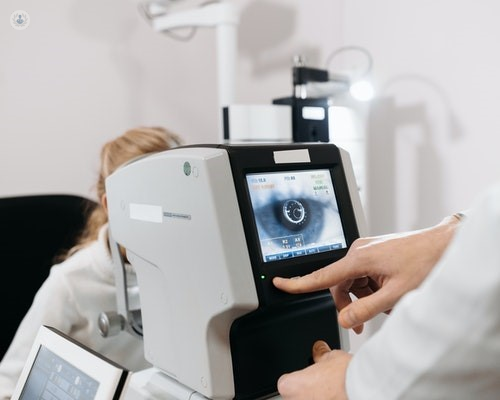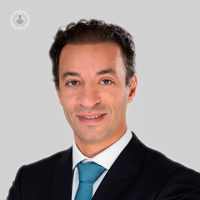ICL implants
Written by:ICL implants are the chosen solution for many people who struggle with different eye problems and don’t want to wear glasses or constantly insert and remove contact lenses. Mr Radwan Almousa, one of London’s top consultant ophthalmologists, explains how an ICL works, the implantation procedure and more.

What is an ICL implant?
ICL (Implantable collamer lens) or Implantable Contact Lens, as the name implies, is an artificial lens implanted inside the eye to correct refractive errors, like short-sightedness, long-sightedness or astigmatism.
In what part of the eye is the implant placed? What is involved in the implantation procedure?
The ICL is implanted between the iris and the normal lens, which will keep it away from the cornea and closer to the normal lens’ natural position. This positioning makes these lenses safer than the old iris clip lenses, as in theory they don’t rub against the back of the cornea which typically damages it and causes vision deterioration.
The procedure is usually done under local anaesthesia. It involves making a microscopic corneal incision through which the ICL lens would be implanted behind the iris. The incision is usually watertight and doesn’t need suturing.
Is the procedure painful and are there any risks involved?
In general, the procedure is painless and the pain is controlled with topical anaesthetic. One of the possible risks involved with the surgery could be bleeding inside the eye, which is usually self-resolving.
Increased eye pressure might be associated with ICL surgery and if it becomes a long-term issue, ICL explantation (removal) might be considered. The risk of cataract formation (normal lens cloudiness) over the ten years after surgery is less than one per cent. However, if the cataract was visually significant, another surgery might be needed to remove it and improve vision.
What should people avoid doing after the procedure?
After surgery the patient should avoid rubbing the eye. Although the lens sits securely behind the iris, there is a theoretical risk of causing damage to the cornea if the patient forces the cornea against the artificial lens through rubbing the eye. Even in the case of no lens implant in the eye, excessive eye rubbing could cause damage to the cornea and increased lid laxity among other ocular detrimental effects, so it should be avoided.
How long do ICL implants last?
The materials used to make the ICL lens are inert, meaning they can stay inside the eye without causing any reactive activity. If cataract developed over the years, it might need to be removed along with the ICL implant.
What is the difference between LASIK and ICL?
ICL is a procedure involving implanting a lens inside the eye to correct refractive errors. LASIK is a laser refractive procedure used on the cornea to correct refractive errors. ICL is a reversible procedure, which means that the lens implanted could be removed or replaced if needed, whereas LASIK results can be amended but the procedure is not reversible.
LASIK surgery is known to cause more dry eye symptoms and in terms of visual outcome, the ICL procedure has better outcomes when correcting high perscriptions (more than 6 dioptres of short-sightedness). Laser refractive surgery is still considered less invasive in comparison to ICL.
If you think you may need an ICL implant, or you have any other eye-related health concerns, you can receive Mr Almousa’s expert advice and treatment by visiting his Top Doctors profile, where you can view his schedule and booking information.


